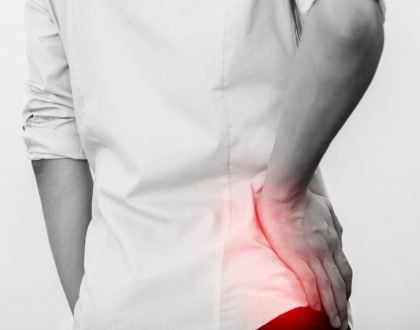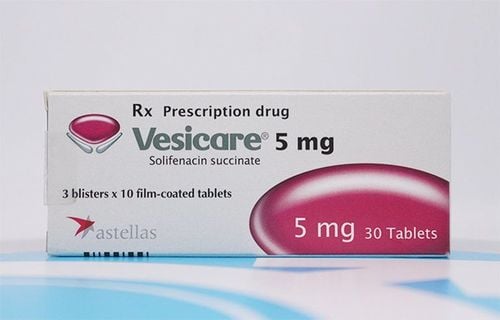This is an automatically translated article.
Sunvesizen 10 mg is a competitive muscarinic antagonist. Sunvesizen is indicated in the treatment of irritable bladder with symptoms of urinary incontinence, urinary frequency, urgency. The following article provides information about the uses, doses and precautions when using Sunvesizen 10mg.1. What is Sunvesizen?
Sunvesizen 10 mg drug has the main active ingredient Solifenacin, the drug is prepared in the form of tablets with a strength of 10mg.Solifenacin is a competitive muscarinic receptor antagonist. Muscarinic receptors play an important role in many cholinergic-mediated functions, including stimulation of salivary secretion and contraction of urinary bladder smooth muscle.
2. Indications and contraindications of the drug Sunvesizen 10mg
2.1. Point
Solifenacin succinate is a competitive muscarinic antagonist. Sunvesizen medicine 10 mg is indicated in the treatment of irritable bladder disease with symptoms of urinary incontinence, urinary frequency, urgency.2.2. Contraindications
Sunvesizen 10 mg is contraindicated in the following patients:Allergy or hypersensitivity to Solifenacin or any of its ingredients. Myasthenia . Urinary retention. Stomach fluid retention. Uncontrolled angle-closure glaucoma. Moderate or severe liver failure. Severe renal impairment and the patient is being treated with a strong inhibitor of CYP3A4 (such as ketoconazole). The patient is on hemodialysis.
2. How to take Sunvesizen 10 mg
2.1. Dosage
Sunvesizen 10 mg drug is taken orally, the drug can be taken with or without meals.The recommended dose of Sunvesizen is 5mg/time x 1 time/day. If the 5 mg dose is well tolerated, the dose may be increased to 10 mg once daily.
Patients with renal impairment: In patients with severe renal impairment with a glomerular filtration rate <30 mL/min, the recommended daily dose of Solifenacin should not be higher than 5 mg. Patients with hepatic impairment: In patients with moderate hepatic impairment Child-Pugh B, the recommended daily dose of Solifenacin should not be higher than 5 mg. Patients with severe liver failure (Child-Pugh C): Do not use Sunvesizen in this subject. Patients taking CYP3A4 inhibitors: In this population, a daily dose of Solifenacin higher than 5 mg is not recommended.
2.2. Overdose of Sunvesizen 10mg and treatment
SymptomsAn overdose of Sunvesizen 10mg has the potential to lead to severe anticholinergic effects and should be managed accordingly. The highest dose of Solifenacin administered orally at a reported incidental overdose was 280 mg orally over a 5-hour period. In this case, changes in mental status appear. Several other cases of Solifenacin overdose have been reported with cognitive impairment. Anticholinergic side effects (pupils unresponsive to stimulation and mydriasis, blurred vision, tremor and dry skin, failure of the heel-to-toe test) have been reported to occur on day 3 in Volunteers with normal health used the drug at a dose of 50mg/day (5 times higher than the highest recommended therapeutic dose). Symptoms usually resolve within 7 days after discontinuing the drug. Treatment
In case of overdose with Sunvesizen 10mg, treat by gastric lavage and apply supportive measures. Electrocardiogram monitoring is recommended.
For other anticholinergic effects, symptoms can be treated as follows:
Severe central anticholinergic effects such as hallucinations, excitement: use physostigmine or carbachol. Convulsions or irritability: treatment with benzodiazepines. Respiratory failure: artificial respiration. Tachycardia: use beta-blockers. Urinary retention: catheterization. Mydriasis: Use eye drops containing pilocarpine, place the patient in a dark room. In the event of an overdose of Sunvesizen, special attention should be paid to patients at risk of QT prolongation (such as hypokalemia, bradycardia and concomitant use of drugs that may prolong the QT interval) and patients with cardiac disease. pre-existing associated vessels (eg, myocardial ischemia, congestive heart failure, arrhythmia).
3. Undesirable effects when using the drug Sunvesizen 10mg
The frequency of adverse effects of the anticholinergic drug Sunvesizen is dose related. Common adverse effects of anticholinergics are dry mouth, constipation, urinary retention, dry eyes, blurred vision (abnormalities of eye accommodation). Dry mouth and constipation have been reported more frequently in patients treated with Solifenacin at 10 mg than in 5 mg. The most common adverse reaction leading to discontinuation was dry mouth with an incidence of 1.5%.Undesirable effects have been reported in >1% of patients: Gastrointestinal: dry mouth, nausea, vomiting, constipation, dyspepsia, upper abdominal pain. Infection: urinary tract infection, flu infection, sore throat. Central nervous system, mental: dizziness, depression. Eyes: blurred vision, dry eyes. Kidney and urinary tract: urinary retention. Body as a whole: lower extremity edema, fatigue. Respiratory: cough Cardiovascular: increased blood pressure. Undesirable effects with unspecified frequency: Systemic: peripheral edema, hypersensitivity reactions, including angioedema with airway obstruction, pruritus, urticaria, rash and anaphylactic reactions. Central nervous system: headache, delirium, hallucinations, confusion and somnolence. Cardiovascular: QT interval prolongation, atrial fibrillation, torsades de pointes, palpitations, tachycardia. Liver: abnormal liver function tests, AST, ALT, GGT. Kidney: renal failure. Metabolism and nutrition disorders: decreased appetite. Skin: exfoliative dermatitis, erythema multiforme. Eyes: glaucoma. Digestive: gastroesophageal reflux disease, intestinal obstruction. Other adverse effects: dysphonia, muscle weakness, cystitis, taste disturbances, abdominal discomfort, dry nose, dry throat, dry skin, dysuria, neuro-vascular edema. Stop using Sunvesizen when experiencing unwanted effects and consult your doctor for timely treatment.
4. Some notes when using Sunvesizen 10mg
Angioedema and anaphylactic reactions Angioedema of the face, lips, tongue, and larynx has been reported with the use of Solifenacin. Some cases occurred shortly after the first dose of Solifenacin. Angioedema involving the upper respiratory tract due to swelling can be life-threatening. In case swelling occurs in the tongue, lower pharynx, larynx, immediately stop using Sunvesizen and treat with appropriate therapy, promptly take necessary measures to ensure airway clearance.Anaphylactic reactions have been reported rarely in patients treated with Solifenacin. Sunvesizen 10mg should not be used in patients with a history of or suspected allergy to Solifenacin. In case the patient has an anaphylactic reaction, immediately discontinue Sunvesizen and apply appropriate therapy.
Urinary retention Like other anticholinergics, Sunvesizen should be used with caution in patients with significant symptoms of bladder obstruction because of the risk of urinary retention.
Gastrointestinal disorders Sunvesizen 10mg should be used with caution in patients with reduced intestinal motility, patients with gastrointestinal obstruction disorders, hernias, gastroesophageal reflux disease and patients on medication. risk of exacerbation of esophagitis.
Central Nervous System Effects Several anticholinergic symptoms on the central nervous system have been reported with the use of Solifenacin, such as headache, hallucinations, confusion and somnolence. Advise patients not to drive or operate machinery until it is known whether the drug has CNS effects. If anticholinergic effects on the central nervous system develop, consider dose reduction or discontinuation of Sunvesizen.
Controlled Angle-closure Glaucoma Use Sunvesizen with caution in patients being treated for angle-closure glaucoma.
Renal failure Use Sunvesizen 10mg with caution in patients with renal failure. Patients with severe renal impairment had a 2.1-fold increase in AUC and 1.6-fold increase in the half-life of solifenacin. Doses of solifenacin succinate higher than 5 mg/day are not recommended in patients with severe renal impairment (glomerular filtration rate < 30 mL/min).
Hepatic impairment Use caution when using Sunvesizen 10mg in patients with impaired liver function. Patients with moderate hepatic impairment experienced a 2-fold increase in the half-life and a 35% increase in the AUC of Solifenacin. Sunvesizen at doses higher than 5 mg/day is not recommended in patients with moderate hepatic impairment (Child-Pugh B) and Sunvesizen is not recommended in patients with severe hepatic impairment (Child-Pugh C). Acquired or Congenital QT interval The QT prolongation effect of Solifenacin has been reported more commonly at the 30 mg dose (3 times the recommended dose) than at the 10 mg dose. This should be considered when prescribing Solifenacin to patients with a history of QT prolongation or who are taking drugs that prolong the QT interval.
QT interval prolongation and torsades de pointes have been reported in patients with risk factors, such as pre-existing QT prolongation and hypokalemia.
Children The efficacy and safety of using Sunvesizen 10mg in pediatric patients has not been established.
Elderly Patients Safety and efficacy with solifenacin have been reported to be similar in older and younger patients (<65 years).
Caution should be exercised when using Sunvesizen 10mg in elderly patients due to the risk of impaired renal function.
Other conditions Other causes of frequent urination (such as kidney disease or heart failure) should be evaluated prior to treatment with Sunvesizen 10mg. If the patient has a urinary tract infection, appropriate antibacterial therapy should be instituted.
Safety and efficacy of Solifenacin have not been established in patients with neurogenic bladder spasm.
The maximum therapeutic effect of Solifenacin can be determined as early as 4 weeks of dosing.
Sunvesizen 10mg contains lactose. Patients with rare hereditary problems of lactose intolerance, lactase deficiency or glucose-galactose malabsorption should not take this medicine.
Ability to drive and operate machinery. Solifenacin may cause blurred vision, drowsiness and fatigue, whereby the ability to drive and use machines may be adversely affected.
Pregnancy There are no adequate and well-controlled studies of the use of Solifenacin in pregnant women. Sunvesizen should only be used during pregnancy after carefully weighing the risks and benefits for the mother and fetus.
Lactating women It is not known whether Solifenacin is excreted in human milk. Because many drugs are excreted in human milk, Solifenacin should not be used during lactation. Consider either discontinuing breast-feeding, or discontinuing use of Sunvesizen in nursing mothers.
5. Drug interactions
Ketoconazole: Solifenacin is recommended at a dose not exceeding 5 mg/day when co-administered with therapeutic doses of ketoconazole, or other strong inhibitors of CYP3A4 (nelfinavir, ritonavir, itraconazole). Concomitant use of Solifenacin and other strong inhibitors of CYP3A4 is contraindicated in patients with severe renal impairment or moderate hepatic impairment.
Inducers of CYP3A4 may decrease the concentration of Solifenacin. As Solifenacin is metabolised by CYP3A4, pharmacokinetic interactions are possible with other substrates of CYP3A4 with higher affinity (diltiazem, verapamil) and inducers of CYP3A4 (phenytoin, rifampicin, carbamazepine).
Drugs with other anticholinergic properties: Concomitant use with Sunvesizen may lead to increased therapeutic efficacy and increased undesirable effects. Discontinue solifenacin approximately 1 week before starting another anticholinergic drug. The therapeutic effect of Solifenacin may be reduced when co-administered with cholinergic receptor agonists.
Drugs that stimulate gastric and intestinal motility, such as metoclopramide and cisapride: Sunvesizen may decrease the effects of these drugs.
Please dial HOTLINE for more information or register for an appointment HERE. Download MyVinmec app to make appointments faster and to manage your bookings easily.













